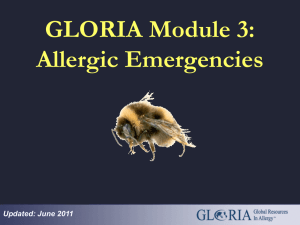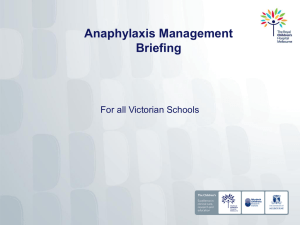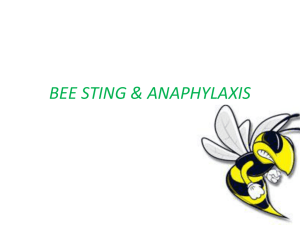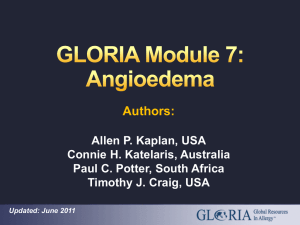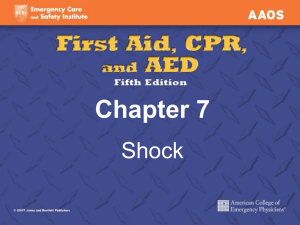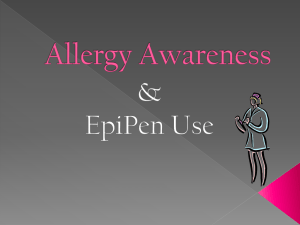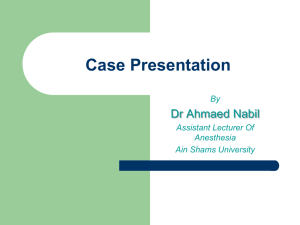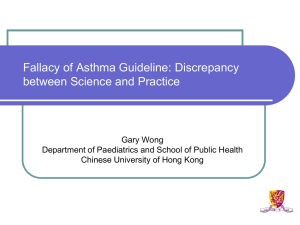GLORIA Module 3 Allergic Emergencies
advertisement
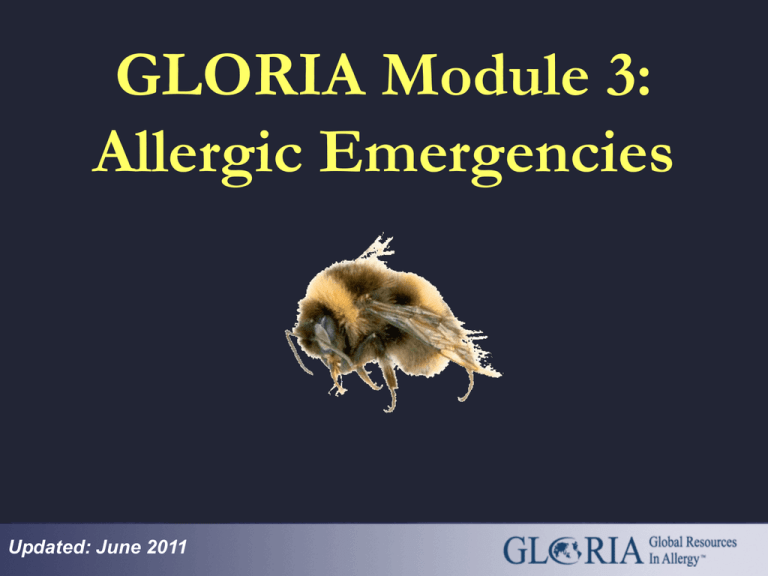
GLORIA Module 3: Allergic Emergencies Updated: June 2011 Global Resources in Allergy (GLORIA™) Global Resources In Allergy (GLORIA™) is the flagship program of the World Allergy Organization (WAO). Its curriculum educates medical professionals worldwide through regional and national presentations. GLORIA modules are created from established guidelines and recommendations to address different aspects of allergy-related patient care. World Allergy Organization (WAO) The World Allergy Organization is an international coalition of 89 regional and national allergy and clinical immunology societies. WAO’s Mission WAO’s mission is to be a global resource and advocate in the field of allergy, advancing excellence in clinical care, education, research and training through a world-wide alliance of allergy and clinical immunology societies GLORIA Module 3: Allergic Emergencies Allergic emergencies WAO Expert Panel Authors: Richard F Lockey, USA Connie H Katelaris, Australia Michael Kaliner, USA Contributors: F.Estelle R. Simons, Canada Daniel Vervloet, France Allergic Emergencies Section 1: Anaphylaxis Anaphylaxis lecture objectives After this lecture, participants will: • Have knowledge of the different mechanisms which cause anaphylaxis and the agents which are most likely to cause it; • Be able to recognize the signs and symptoms of anaphylaxis; • Understand how to treat anaphylaxis. Definition of anaphylaxis • Anaphylaxis – a syndrome with varied mechanisms, clinical presentations, and severity. • An acute life-threatening reaction. • Usually mediated by an immunologic mechanism, allergic anaphylaxis, but not always. • Includes non-allergic anaphylaxis (formerly referred to as an anaphylactoid reaction). • Results from the release of mast-basophil mediators. WAO Nomenclature Review Committee JACI 2004 Gell and Coombs’ Hypersensitivity (immunopathologic reactions) • • • • Type I Type II Type III Type IV Immediate Cytotoxic Immune Complex Delayed Hypersensitivity • Types I, II and III can result in immunologically-induced or allergic anaphylaxis Kemp and Lockey JACI 2002 Biochemical mediators and chemotactic substances • Degranulation of mast cells and basophils. • Preformed granule-associated substances, e.g., histamine, tryptase, chymase, heparin, histaminereleasing factor, other cytokines. • Newly generated lipid-derived mediators, e.g., prostaglandin D2, leukotriene B4, PAF, LTC4, LTD4, and LTE4. • Eosinophils may play pro-inflammatory role (release of cytotoxic granule-associated proteins) or antiinflammatory role (e.g., metabolism of vasoactive mediators). Kemp and Lockey JACI 2002 Shock organs in anaphylaxis Guinea pig – bronchial smooth muscle constriction. Rabbit – fatal pulmonary artery vasoconstriction with right ventricular failure. Dog – venous system of liver contracts producing hepatic congestion. Human – shock organs are the cardiovascular system, respiratory tract, skin, and gastrointestinal tract. Laryngeal oedema, respiratory failure, and circulatory collapse are common. Asthma is an important risk factor for death from anaphylaxis. Kemp and Lockey JACI 2002 Bock, Munoz-Furlong, Sampson JACI 2001 Incidence • Analysis of published studies of most common causes • 3.3 to 4 million Americans at risk. • 1,433 to 1,503 at risk for fatal reaction. Incidence Based on Epinephrine Rx for Out-of-Hospital Use • From Canada and Wales. • 0.95% of population in Manitoba, Canada. • 0.2 per 1000 in Wales. • Incidence increased in Wales between 1994 & 1999. Neugut, Ghatak, Miller Arch Int Med 2001 Simons, Peterson, Black JACI 2002 Rangaraj, Tuthill, Burr, Alfaham JACI 2002 Incidence of anaphylaxis to specific agents 1 Antibiotics • Most common cause of drug induced anaphylaxis. Latex • Increased incidence last decade. • Population at risk includes multiple mucosal exposure to latex (catheterization & surgery) and healthcare workers. Radiocontrast agents • Introduction of lower osmolarity agents reduced reaction rate Lieberman In: Allergy: Principles and Practice. Mosby, 2003 Incidence of anaphylaxis to specific agents 2 Hymenoptera stings • Incidence ranges from 0.4% to 5% • Estimated fatalities 100 per year in U.S.A. Food • Estimated 2% of US population has food allergies with up to 100 deaths per year • Shellfish most common in adults; peanuts in children Lieberman In Allergy: Principles and Practice Mosby, 2003 Incidence of anaphylaxis to specific agents 3 Perioperative anaphylaxis • Incidence ranges from 1 in 4500 to 1 in 2500 cases of general anaesthesia • Mortality rate can be as high as 3.4% • Most common agents responsible are muscle relaxants, which account for 50% to 75% of reactions. Lieberman In Allergy: Principles and Practice Mosby, 2003 Incidence of anaphylaxis to specific agents 4 Non Steroidal Anti-Inflammatory Drugs (NSAIDs) Incidence varies depending on whether asthmatic subjects are included NSAIDs probably second most common offending drug next to antibiotics Lieberman In Allergy: Principles and Practice Mosby, 2003 Incidence of anaphylaxis to specific agents 5 Antisera • Heterologous antisera to treat snake bites (4.6% to 10%) • Immunosuppression, incidence for anti-lymphocyte globulin as high as 2% Idiopathic • Estimated to be between 20,592 and 47,024 cases in USA – deaths rare Lieberman in Allergy: Principles and Practice Mosby 2003 Allergen immunotherapy • Incidence of systemic reaction from 0.8% to 46.7% depending on the dose of allergen and schedule used. • Deaths occur at a rate of 1 per 2,000,000 injections. Stewart and Lockey JACI 1992 Kemp et al In: Allergens and Allergen Immunotherapy, Marcel Dekker, 2004 Signs and symptoms of anaphylaxis • • • • • • • • Diffuse erythema Diffuse pruritus Diffuse urticaria Angioedema Bronchospasm Laryngeal edema Hyperperistalsis Hypotension Kemp and Lockey JACI 2002 • • • • • • • • Cardiac arrhythmias Nausea Vomiting Lightheadedness Headache Feeling of impending doom Unconsciousness Flushing Differential diagnostic considerations in anaphylaxis Vasovagal reactions Idiopathic flushing Mastocytosis Carcinoid syndrome Anxiety-induced hyperventilation Globus hystericus Serum sickness C-1 esterase inhibitor deficiency Shock-associated with myocardial infarction, blood loss, septicemia Scombroid poisoning Montanaro and Bardana JACI 2002 Comments about signs and symptoms of anaphylaxis Urticaria or angioedema and flush most common ( > 90%) Cutaneous manifestations may be delayed or absent Next most common manifestations are respiratory (40% to 60%) Next are dizziness, unconsciousness (30% to 35%) Gastrointestinal symptoms (20% to 30%) More rapid onset, more likely serious Signs and symptoms within 5 to 30 minutes, but may not develop for hours Lieberman In Allergy: Principles and Practice Mosby, 2003 Agents that cause anaphylaxis 1 anaphylactic (IgE-dependent) • Foods (peanut, tree nuts, and crustaceans) • Milk, egg and fish also important, especially in children • Medications (antibiotics) • Venoms • Latex • Allergen vaccines • Hormones • Animal or human proteins • Diagnostic allergens Kemp Immunol Allergy Clin N Am 2001 • Muscle relaxants • Colorants (insect-derived, such as carmine) • Enzymes • Polysaccharides • Aspirin and other non-steroidal antiinflammatory drugs (probably) • Exercise (possibly, in food and medication-dependent events) Agents that cause anaphylaxis 2 (allergic but not IgE mediated) Immune aggregates (Type II) • Intravenous immunoglobulin • Dextran (possibly) Cytotoxic (Type III) • Transfusion reactions to cellular elements (IgG, IgM) Kemp Immunol Allergy Clin N Am 2001 Agents that cause anaphylaxis 3 (non-allergic or IgE-independent) Multimediator complement activation/activation of contact system: Radiocontrast media Ethylene oxide gas on dialysis tubing Protamine (possibly) ACE-inhibitor administered during renal dialysis with sulfonated polyacrylonitrile, cuprophane, or polymethylmethacrylate dialysis membranes Kemp Immunol Allergy Clin N Am 2001 Agents that cause anaphylaxis 4 (non-allergic or IgE independent) Nonspecific degranulation of mast cells and basophils Opiates Idiopathic Physical factors: Exercise Temperature (cold, heat) Kemp Immunol Allergy Clin N Am 2001 -Adrenergic blockade • By mouth or topically • Paradoxical bradycardia, profound hypotension, and severe bronchospasm • Can exacerbate disease and may impede treatment • Selective β-blockers do not produce clinically significant adverse respiratory effects in mild-moderate asthma (including COPD). Not studied in anaphylaxis Toogood CMAJ 1987 Kivity and Yarchovsky JACI 1990 Salpeter, Ormiston, Salpeter Annals Int Med 2002 Recurrent and persistent anaphylaxis • Recurrent or biphasic anaphylaxis occurs 8 to 12 hours in up to 20%. • Subjects with biphasic do not differ clinically but more epinephrine may be necessary for initial symptoms. • Persistent anaphylaxis may last from 5 to 32 hours. Lee and Greenes Pediatrics, 2000 Kemp and deShazo In: Allergens and Allergen Immunotherapy to Treat Allergic Diseases. Marcel Dekker, 2004 Physician-supervised management of anaphylaxis 1 I. Immediate Intervention a) Assessment of airway, breathing, circulation, and mentation. b) Administer EPI, 1:1000 dilution, 0.3 - 0.5 ml (0.01 mg/kg in children, max 0.3 mg dosage) IM, to control SX and BP. Repeat, as necessary. Kemp and Lockey JACI 2002 Simons et al JACI 1998 Simons, Gu, Simons JACI 2001 Physician-supervised management of anaphylaxis 2 I. Immediate Intervention - continued c) IM into the anterolateral thigh (vastus lateralis) produces higher & more rapid peak plasma level versus SQ & IM in arm. Therefore, with moderate, severe, or progressive ANA, EPI IM into anterolateral thigh. Alternatively, an EPI autoinjector given through clothing in same manner. Repeat, as necessary. Kemp and Lockey JACI 2002 Simons et al JACI 1998 Simons, Gu, Simons JACI 2001 Physician-supervised management of anaphylaxis 3 I. Immediate Intervention – continued d) Aqueous EPI 1:1000, 0.1- 0.3ml in 10ml NS (1:100,000 to 1:33,000 dilution), IV over several minutes prn. e) For potentially moribund subjects, tubercular syringe, EPI 1:1000, 0.1 ml, insert into vein (IV), aspirate 0.9 ml of blood (1:10,000 dilution). Give as necessary for response. Kemp and Lockey JACI 2002 Physician-supervised management of anaphylaxis 4 II. General measures a) Place in recumbent position and elevate lower extremities. b) Maintain airway (endotracheal tube or cricothyrotomy). c) O2, 6 - 8 liters/minute. d) NS, IV. If severe hypotension, give volume expanders (colloid solution). e) Venous tourniquet above reaction site. Question if decreases absorption of allergen. Kemp and Lockey JACI 2002 Physician-supervised management of anaphylaxis 4 III. Specific Measures that Depend on Clinical Scenario a) Aqueous EPI 1:1,000, ½ dose (0.1- 0.2 mg) at reaction site. b) Diphenhydramine, 50 mg or more in divided doses orally or IV, maximum daily dose 200 mg (5 mg/kg) for children and 400 mg for adults. c) Ranitidine, 50 mg in adults and 12.5 - 50 mg (1 mg/kg) in children, dilute in 5% G/W, total 20 ml, inject IV, over 5 minutes. (Cimetidine 4 mg/kg OK for adults, not established for pediatrics). Kemp and Lockey JACI 2002 Physician-supervised management of anaphylaxis 5 III. Specific Measures that Depend on Clinical Scenario d) Bronchospasm, nebulized albuterol 2.5 – 5 mg in 3 ml NS or levalbuterol 0.63 - 1.25 mg as needed. e) Aminophylline, 5mg/kg over 30 min IV may be helpful. Adjust dose based on age, medications, disease, current use. f) Refractory hypotension, give dopamine, 400 mg in 500 ml G/W IV 2 - 20 μg/kg/min more or less. Kemp and Lockey JACI 2002 Physician-supervised management of anaphylaxis 6 III. Specific Measures that Depend on Clinical Scenario g) Glucagon, 1- 5 mg (20 - 30 μg/kg [max 1 mg] in children), administered IV over 5 minutes followed with IV infusion 5-15 μg/min. h) Methylprednisolone, 1- 2 mg/kg per 24 hr; prevents prolonged reactions and relapses. Kemp and Lockey JACI 2002 Vasodepressor (Vaso-Vagal) Definition • Non-allergic reaction characterized by slow pulse nausea, pallor, sweating, clammy skin, and/or hypotension Kemp and Lockey JACI 2002 Vasodepressor (Vaso-Vagal) Management a) Place patient in supine position with elevated lower extremities b) For severe vasodepressor reaction ONLY (i.e., bradycardia, nausea, pallor, sweating, cool clammy skin, hypotension), atropine 0.3 - 0.5 mg (0.02 mg/kg) SQ every 10 minutes (max 2 mg/adult and 1 mg/child) c) If hypotension persists, give IV fluids Kemp and Lockey JACI 2002 Measures to reduce the incidence of druginduced anaphylaxis and anaphylactic deaths 1 General Measures • Obtain thorough history for drug allergy • Avoid drugs with immunological or biochemical cross-reactivity with any agents to which the patient is sensitive • Administer drugs orally rather than parenterally when possible • Check all drugs for proper labeling • Keep patients in clinic for 20 to 30 minutes after injections Lieberman In: Allergy: Principles and Practice Mosby, 2003 Measures to reduce the incidence of anaphylaxis and anaphylactic deaths 2 Measures for Patients at Risk • Avoid causative factor/s • Have patient wear and carry warning identification • Teach self-injection of epinephrine and caution patient to keep epinephrine kit with them. • Discontinue -adrenergic blocking agents, ACE inhibitors (controversial), monoamine oxidase inhibitors, and tricyclic antidepressants, where possible. Lieberman In: Allergy: Principles and Practice. Mosby, 2003 Measures to reduce the incidence of anaphylaxis and anaphylactic deaths 3 Measures for Patients at Risk • Use preventive techniques when patient is required to undergo a procedure or take an agent which places them at risk. Such techniques include: Pretreatment Provocative challenge Desensitization Lieberman In: Allergy: Principles and Practice. Mosby, 2003 Summary Prognosis Factor Poor Good Dose of antigen (allergen) Large Small Onset of symptoms Early Late Initiation of treatment Late Early Route of exposure Parenteral Oral* β-adrenergic blocker use Yes No Presence of underlying disease Yes No * True for drugs, not foods Allergic Emergencies Section 2: Upper Airway Oedema Upper airway oedema lecture objectives • To understand the causes of angioedema; • To review the spectrum and management of hereditary angioedema; • To review Angiotensin Converting Enzyme (ACE) inhibitor related angioedema. Outline of lecture • Clinical description • Classification • Examples of life-threatening oedema: – Hereditary angioedema – Acquired oedema – Angiotensin enzyme inhibitor-induced oedema • Clinical description • Pathophysiology • Management Angioedema • First described by Quincke in 1882 • Well-demarcated non-pitting oedema • Caused by same pathological factors that cause urticaria • Reaction occurs deeper in dermis and subcutaneous tissues • Face, tongue, lips, eyelids most commonly affected • May cause life-threatening respiratory distress if larynx involved Classification of angioedema 1 Hereditary • Type 1: C1 esterase inhibitor deficiency • Type 2: functional abnormality of C1 esterase inhibitor Acquired • Idiopathic • IgE-mediated • Non-IgE-mediated • Systemic disease • Physical causes • Other Classification of angioedema 2 IgE-mediated • • • • Drugs Foods Stings Infections (eg viral, helminthic) Non-IgE-mediated • Cyclooxygenase inhibition (ASA and other NSAIDS) • Angiotensin converting enzyme inhibition Classification of angioedema 3 Systemic diseases • Systemic lupus erythematosis • Hypereosinophilia • Lymphoma: abnormal antibodies activate complement system Classification of angioedema 4 Physical causes • Cold • Cholinergic • Solar • Vibratory Other • Some contact reactions • Autoantibodies to C1-esterase inhibitor • Unopposed complement activation Incidence • Chronic idiopathic urticaria/angioedema occurs in 0.1% population • 65% remit within 3 years 85% remit within 5 years 95% remit within 10 years • Angioedema occurs most commonly with urticaria (40% cases) • May occur in isolation (10% cases) Hereditary Angioedema (HAE) • 1888 - family described by William Osler • 1963 - Donaldson and Evans described the biochemical defect responsible - absence of C1 inhibitor Hereditary Angioedema (HAE) Subtypes Type 1* • Autosomal dominant • Markedly suppressed C1 esterase inhibitor protein levels * Accounts for 85% cases Hereditary Angioedema (HAE) Subtypes Type 2* Autosomal dominant, with a point mutation leading to synthesis of a dysfunctional protein Functional assay required for diagnosis as level may be normal * Accounts for 15% cases Hereditary Angioedema (HAE) Epidemiology • 1:10,000 - 1:150,000 with no racial or gender predilection Clinical manifestations • Usually manifests in 2nd decade • May be seen in young children • Oedema may develop in one or several organs • Presentation depends upon site of swelling • Attacks last 2- 5 days before spontaneous resolution Nzeako Arch Intern Med, 2001 Clinical manifestations 1 • Angioedema may develop in subcutaneous tissues of extremities, genitalia, face, trunk Clinical manifestations 2 • Oedema of wall of intestine may present as an acute abdominal emergency • Submucosal oedema of larynx or pharynx may cause asphyxiation – this may occur on first presentation Bork Mayo Clin Proc 2000 Clinical manifestations 3 Laryngeal oedema Commonest cause of mortality in HAE • Time from onset of swelling to death 1- 14 hours (mean 7 hours) • May be presenting feature • Death may occur in those with no previous laryngeal oedema episodes • Increased risk within certain families • Early symptoms - lump in throat, tightness in throat • Hoarseness, dysphagia, progressive dyspnoea Bork Mayo Clin Proc 2000 Hereditary Angioedema (HAE) Diagnosis • Clinical presentation • For screening - quantitative and functional assays of C1 inhibitor • C4 and C2 levels reduced in acute attack • C4 persistently low in most patients Nzeako Arch Intern Med 2001 Hereditary Angioedema (HAE) pathophysiology 1 C1 inhibitor • Single chain glycoprotein; molecular weight 104,000; serine protease family • Important regulatory protein of complement cascade • Inactivates C1 esterase complex • Regulates coagulation, fibrinolytic, kinin, complement systems Nielson Immunopharmacology 1996 Hereditary Angioedema (HAE) pathophysiology 2 • Lack of C1 inhibitor leads to abnormal activation of complement pathway, reduced C2 and C4 levels • Hageman factor induces formation of kallikrein from prekallikrein • Bradykinin is released from high molecular weight kininogen • All these mediators increase capillary permeability and are responsible for attacks of angioedema Kaplan JACI 2002 Genetics • Autosomal dominant; all patients heterozygous • 25% no prior family history - spontaneous mutations • More than 100 different mutations reported • Varied clinical pattern may be explained by variable effect of mutations on C1 inhibitor synthesis Agostini Medicine (Baltimore) 1992 Hereditary Angioedema (HAE) management Principles • Action plan for acute episodes • Strategy for long term prophylaxis • Short term prophylaxis for high risk procedures • Regular follow up for education and monitoring side effects of therapy Management 1 Acute attacks • Treatment of choice is C1 inhibitor concentrate, 500 - 1,000U intravenous infusion • Safe and effective - no long term side effects reported • Excellent and prompt response in most patients • Not available in USA, but in clinical trials Bork Arch Intern Med 2001 Management 2 Acute attacks when C1 inhibitor concentrate not available • Intubation and respiratory support may be necessary when laryngeal oedema present • Fresh frozen plasma (FFP) has been used successfully for acute attacks. Exacerbation of symptoms by supplying more kallikrein substrate is a theoretical consideration but is rarely seen Bork Arch Intern Med 2001 Management 3 Long term – adults • Attenuated androgens (stanozolol, danazol, oxandrin) can prevent attacks • Increase levels of C1 inhibitor, C4 and C2 • Titrate to lowest effective dose to control attacks - for danazol may be able to reduce to 200 mg/d every second day • Regular monitoring necessary Nzeako Arch Intern Med 2001 Management 4 Long term – children • Antifibrinolytic agents have been used as first line prophylaxis • Low dose danazol Nzeako Arch Intern Med 2001 Management 5 Short term prophylaxis • Necessary for high risk interventions, eg, dental procedures, tonsillectomy • C1 inhibitor concentrate, where available, given before procedure • Increasing dose of attenuated androgen for a few days beforehand • Fresh frozen plasma Management 6 Other • Avoid oral contraceptive pill, ACE inhibitor medication • Premedicate before procedures requiring radiocontrast media or streptokinase as they may decrease C1 inhibitor levels • Reassurance; address issues such as ongoing stress • Treat infections promptly • Genetic counseling and screening Acquired Angioedema (AAE) 1 Type 1 – Associated with rheumatologic diseases, B cell lymphoproliferative disorders – Activation of complement by complexes of anti-idiotypic antibodies and surface immunoglobulins consumes C1 inhibitor so levels decline Type 2 – Development of autoantibodies against C1 inhibitor – Autoantibodies bind at active site on molecule leading to inactivation Markovic Ann Int Med 2000 Acquired Angioedema (AAE) 2 • Decreased C1q levels distinguish AAE from HAE where C1q is usually normal • Treatment of underlying condition may result in resolution • For acute attacks, C1 inhibitor concentrate, where available should be used • Attenuated androgen may be useful in Type 1 • Immunosuppressive therapy for Type 2 Laurent Clin Rev Allergy Immunol 1999 Angiotensin Converting Enzyme (ACE) inhibitors and angioedema 1 • Angioedema develops in 0.1% to 0.5% of those receiving the drug • Onset from 1st week of use to 2 - 3 years of use • Symptoms resolve within 24 - 48 hours of cessation of drug • Most commonly seen with captopril and enalopril but described with all in class • Genetic factors may be important • Subjects with a history of angioedema from other causes are more susceptible to ACE-induced angioedema Slater JAMA 1988 Angiotensin Converting Enzyme (ACE) inhibitors and angioedema 2 • Face and lips most commonly involved but laryngeal oedema reported • Risk factors include obesity, prior endotracheal intubation and face and neck surgery • ACE inhibitors will trigger attacks in those with HAE so avoid in these patients Jain Chest 1992 Angiotensin Converting Enzyme (ACE) inhibitors and angioedema 3 Pathophysiology • ACE inhibitors may cause bradykinin accumulation resulting in vasodilatation, capillary leakage and angioedema • Patients may have a congenital or acquired impairment of kininase 1 which degrades bradykinin leading to bradykinin accumulation once ACE is blocked Angiotensin Converting Enzyme (ACE) inhibitors and angioedema 4 Management • Stop drug and use other classes of antihypertensive agents • ALL ACE inhibitors are to be avoided • Management of angioedema depends on site of involvement - securing the airway by intubation may be necessary • ACE receptor antagonists are generally considered to be safe Angioedema - conclusions • Most often occurs in association with urticaria • When angioedema occurs alone, consider HAE, AAE • HAE is a rare disease but must be identified as it can be life-threatening • Refer to appropriate specialist for ongoing management • ACE-inhibitor induced angioedema is an important cause in older people Allergic Emergencies Section 3: Severe Asthma Exacerbations Lecture objectives At the end of this lecture participants will be able to: • Understand the risk factors for asthma exacerbations • Identify the signs and symptoms of acute asthma • Outline appropriate treatment strategies Features of a severe asthma exacerbation One or more present: – – – – – – – Use of accessory muscles of respiration Pulsus paradoxicus >25 mm Hg Pulse > 110 BPM Inability to speak sentences Respiratory rate >25 - 30 breaths/min PEFR or FEV1 < 50% predicted SaO2 <91- 92% McFadden Am J Respir Crit Care Med 2003 Risk factors for fatal or near-fatal asthma attacks • • • • • • • • Previous episode of near-fatal asthma Multiple prior ER visits or hospitalizations Poor compliance with medical treatments Adolescents or inner city asthmatics (USA) African-Americans>Hispanics>Caucasians Allergy to Alternaria Recent use of oral CCS Inadequate therapy: – Excessive use of β-agonists – No inhaled CCS – Concomitant β-blockers Ramirez and Lockey In: Asthma, American College of Physicians, 2002 Physical findings in severe asthma exacerbations • • • • • • • • • • Tachypnea Tachycardia Wheeze Hyperinflation Accessory muscle use Pulsus paradoxicus Diaphoresis Cyanosis Sweating Obtundation Brenner, Tyndall and Crain In: Emergency Asthma. Marcel Dekker 1999 Causes of asthma exacerbations • • • • Lower or upper respiratory infections Cessation or reduction of medication Concomitant medication, e.g. β-blocker Allergen or pollutant exposure Differential diagnosis • • • • • • COPD Bronchitis Bronchiectasis Endobronchial diseases Foreign bodies Extra- or intra-thoracic tracheal obstruction • Cardiogenic pulmonary edema Brenner, Tyndall, Crain In: Emergency Asthma. Marcel Dekker, 1999 • Non-cardiogenic pulmonary edema • Pneumonia • Pulmonary emboli • Chemical pneumonitis • Hyperventilation syndrome • Pulmonary embolus • Carcinoid syndrome Peak flow meters Use peak flow meters to monitor asthma and prevent exacerbations: • • • • • • Inexpensive Easy to use Accurate Provide “real life” measurements at worst and best times of the day Provide objective measurement of pulmonary function Detect early changes of asthma worsening Patient “self management” If personal best peak flow measurements: – Fall 10+%, double dose of inhaled CCS – Fall 20+%, use short-acting bronchodilator Q4 -6 hour, plus 2 x inhaled CCS – Call office, try to determine if infection is present – Fall 40 - 50%, add oral CCS – Fall greater than 50%, urgent visit to either – Outpatient office • Emergency room Kaliner In: Current Review of Asthma. Curent Medicine, 2003 Stages of asthma exacerbations stage 1: Symptoms • Somewhat short of breath • Can lie down and sleep through the night • Cannot perform full physical activities without shortness of breath Signs • • • • Some wheezes on examination Respiratory rate, 15 (normal <12) Pulse 100 Peak flows and spirometry reduced by 10% Stages of asthma exacerbations stage 2: Symptoms • Less able to do physical activity due to shortness of breath • Dyspnea on walking stairs • May wake up at night short of breath • Uncomfortable on lying down • Some use of accessory muscles of respiration Signs • Wheezing • Respiratory rate 18 • Pulse 111 • Peak flows and spirometry reduced by 20+% Stages of asthma exacerbations stage 3: Symptoms • Unable to perform physical activity without shortness of breath • Cannot lie down without dyspnea • Speaks in short sentences • Using accessory muscles Signs • Wheezing • Respiratory rate 19 - 20 • Pulse 120 • Peak flows and spirometry reduced by 30+% Stages of asthma exacerbations stage 4: Symptoms • Sitting bent forward • Unable to ambulate without shortness of breath • Single word sentences • Mentally-oriented and alert • Use of accessory muscles Signs • Wheezing less pronounced than anticipated • Respiratory rate 20 - 25 • Pulse 125+ • Peak flows and spirometry reduced by 40+% • SaO2 91- 92% Stages of asthma exacerbations stage 5: Symptoms • Reduced consciousness • Dyspnea • Silent chest – no wheezing Signs • Fast, superficial respiration • Respiratory rate >25 • Unable to perform peak flows or spirometry • Pulse 130 - 150+ • SAO2 <90 Severity of asthma as graded by % predicted FEV1 FEV% predicted Severity • • • • • Mild Moderate Moderately severe Severe Very severe (life-threatening) 70 - 100 60 - 69 50 - 59 35 - 49 < 35 Treatment of asthma exacerbations 1 Preferred treatment choices – β2-agonists • Inhaled by MDI or nebulizer • Injected – Anticholinergics • Inhaled by MDI or nebulizer – Corticosteroids • Parenteral, oral or inhaled Treatment of asthma exacerbations 2 Secondary treatment choices – – – – Aminophylline or theophylline (oral, parenteral) Leukotriene receptor antagonists (oral) Oxygen Magnesium sulfate Treatment of asthma exacerbations 3 beta agonists Inhaled is preferred route – – – – MDI plus spacer, 4 - 8 puffs Q 20 min x 3 Nebulizer, 2.5 - 5 mg albuterol Q 20 min x 3 Epinephrine SQ, 0.3 - 0.5ml (0.01 ml/kg children) Levalbuterol, 0.63 - 1.25 mg Q 4 - 8 hours (if available) Treatment of asthma exacerbations 4 anticholinergics Ipratropium – Preferred use: combined with beta agonist – MDI plus spacer, 2 - 4 puffs Q 20 min x 3 – Nebulizer, 500 μg Q 20 min x 3 Treatment of asthma exacerbations 5 corticosteroids • • • • • No immediate effect Earliest effects 6 hours after high dose Oral is as effective as parenteral Prednisone (equivalent), 45 - 60 mg Higher doses have increased side effects and no appreciable increased therapeutic benefit • Methylprednisolone, 1 – 2 mg/kg/24 hours • No substantial data for usefulness in acute setting Treatment of asthma exacerbations 6 aminophylline and theophylline • Controversial: – Added no benefit to inhaled beta agonists – Increased complications • Loading dose for aminophylline: 5 – 6 mg/kg over 20 - 30 min • Maintenance dose: 0.4 mg/kg/hr (adjust for heart and liver disease) • Try to achieve 5 - 15 μg/ml, monitor plasma levels to adjust dose • Doses for theophylline similar but slightly less Treatment of asthma exacerbations 7 leukotriene modifiers • • • • Few studies Suggest usefulness in reducing hospitalizations Montelukast, 10 mg orally Zafirlukast, 20 mg orally Treatment of asthma exacerbations 8 magnesium sulfate • Controversial: – Inconsistent data • Used in very severe asthma in emergency settings: – FEV1 < 25% predicted – Other signs of severe disease • 1.2 - 2 gm IV over 10 - 20 min in 50 ml saline • Minor side effects Preventing exacerbations 1 oral corticosteroids • Oral corticosteroids are the most powerful medications available to reduce airway inflammation • Use until attack completely abated: – PEFR and FEV1 at baseline levels – Symptoms gone • Taper to QOD and determine if patient can remain well if corticosteroids are withdrawn completely Preventing exacerbations 2 inhaled corticosteroids • Place patient on high dose inhaled corticosteroids – Fluticasone, 880 - 1760 μg – Budesonide, 800 - 1600 μg • Once oral corticosteroids are withdrawn, reduce the inhaled dose incrementally, while maintaining PEFR at personal best level • Consider combination of long acting β2-agonist and inhaled corticosteroid in order to achieve the lowest dose of corticosteroid possible Preventing exacerbations 3 underlying causes and patient education Evaluate patient for: – Allergy – Infection – Compliance – Inappropriate concomitant medications – Social factors – Tobacco, drugs, irritants, fumes – Psychiatric disorders Patient education World Allergy Organization (WAO) For more information on the World Allergy Organization (WAO), please visit www.worldallery.org or contact the: WAO Secretariat 555 East Wells Street, Suite 1100 Milwaukee, WI 53202 United States Tel: +1 414 276 1791 Fax: +1 414 276 3349 Email: info@worldallergy.org
